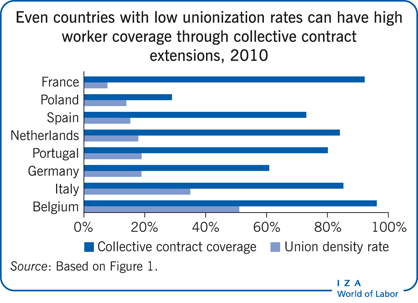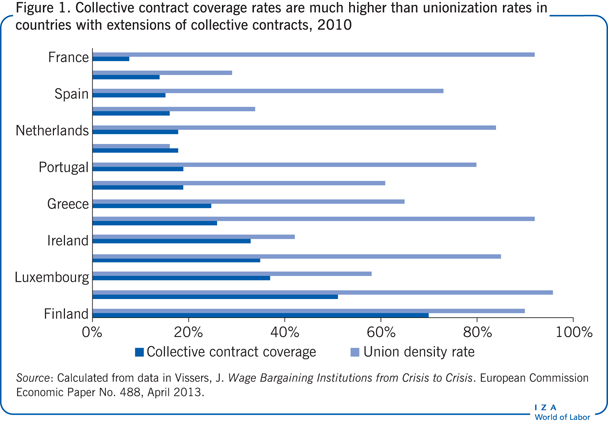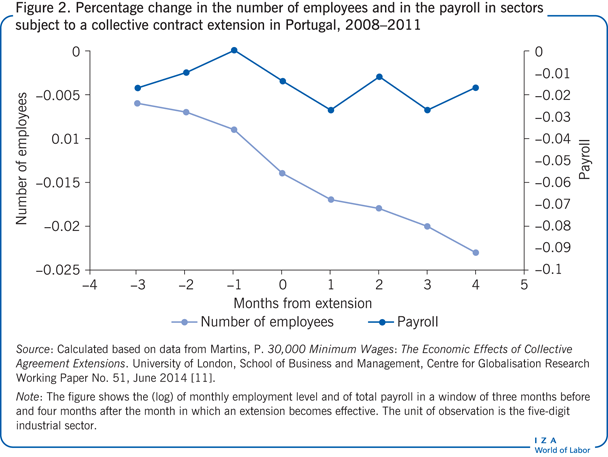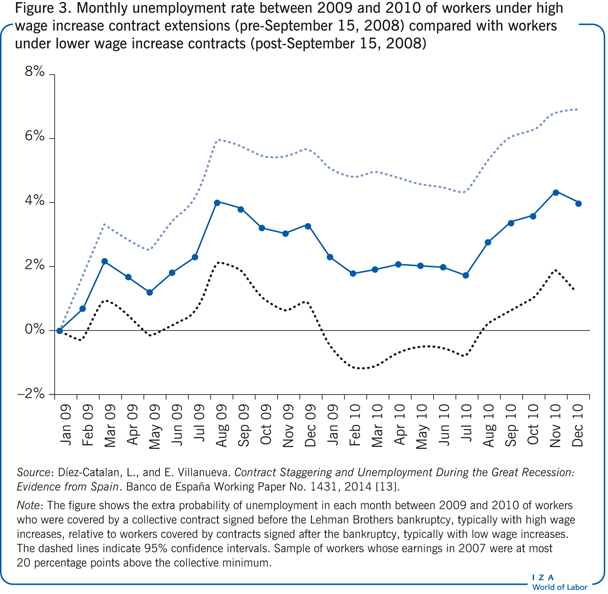Elevator pitch
In many countries, the minimum wages and working conditions set in collective bargaining contracts negotiated by a limited set of employers and unions are subsequently extended to all the employees in an industry. Those extensions ensure common working conditions within the industry, limit wage inequality, and reduce gender wage gaps. However, several studies suggest that those benefits come at the cost of reduced employment levels, especially during recessions. The income losses of workers who are displaced because of a collective contract extension can offset the wage gains among workers who keep their jobs.

Key findings
Pros
Extensions of collective contracts reduce wage inequality by setting occupation-specific minimum wages within an industry.
Extensions reduce gender wage gaps, mainly at the bottom of the wage distribution.
Extensions provide job stayers with insurance against transitory productivity fluctuations or economy-wide fluctuations associated with the business cycle.
In the absence of full mobility across jobs, extensions avoid opportunistic cuts in job quality and wages.
Cons
Sector-wide minimum wages increase labor costs to all covered firms, inhibiting employment growth.
Extensions impose working conditions on employers and employees who did not participate in the bargaining process; not all countries require bargaining parties to be representative of the entire industry.
Extensions reduce competition by deterring entry and small business creation.
Extensions introduce wage rigidities that limit the ability of firms to adapt to economic shocks.
Author's main message
The overall impact of extending a collective contract to all firms in an industry depends on how much employment is destroyed as a result of the contract’s provisions concerning minimum wages and other working conditions. Assessing the benefits and costs of extensions requires comparing the increase in earnings among job stayers with the loss in earnings among job losers. New evidence suggests that earnings forgone due to extensions can offset wage gains among job stayers. Allowing firms to opt-out and requiring bargaining parties to represent a majority of employers and employees in the industry may reduce the costs of extensions.
Motivation
Collective contracts regulate the working conditions of unionized and non-unionized workers around the world. Even in countries with low unionization rates, a large proportion of workers is covered by collective contracts through extensions in a legal process through which the working conditions set by a group of employers and employees in an industry or region become binding for all employees and employers.
Collective bargaining contracts reached by a set of employers and employees in an industry or region become binding for all employees and employers in one of three ways: when a public authority, under authority of law, declares the contract binding; when a firm in one region adopts a collective contract signed in another region; or when a firm granted a public contract is required to adopt a collective contract as part of the contract. This paper focuses on the first form of extensions, which are common in France, Germany, the Netherlands, Portugal, South Africa, and Spain, among other countries.
Both employers and employees profit from extensions. Setting minimum bargained wages provides employees with insurance against productivity fluctuations in their firms. Workers in a society with a concentrated distribution of skills and high firing costs prefer wages set in collective contracts to a situation with flexible wages [1]. Employers may also benefit from imposing high bargained wages to all workers, because the resulting increase in costs deters small firms from entering the market [2]. However, these gains can come at the cost of excluding low-skill individuals from the labor market.
It is not surprising then that extensions have been at the center of recent policy reforms in southern Europe. Reformers stress the adverse impact on employment, while defenders argue that extensions play a crucial role in maintaining workers’ income levels and avoiding wage inequality. This paper summarizes recent evidence that quantifies the impact on employment and wages of the extension of collective contracts.
Discussion of pros and cons
Benefits of collective contract extensions: Impacts on wage inequality
The extension of collective bargaining contracts imposes minimum wage requirements on all firms in an industry, potentially compressing the wage distribution and reducing wage inequality. A first indication of that compression effect can be obtained by examining the degree of concentration of earnings around the bargained minimum wage. In Portugal, for example, wages were densely concentrated around bargained minimum wages in a set of industries that represented 10% of the labor force in 1999 [3]. There is similar evidence for Spain, and in both countries earning bargained wages is most common among workers in small firms, female workers, and employees with low tenure [4].
Changes over time in the distribution of earnings can reflect the coverage of collective contract extensions. Germany and Portugal experienced surges in wage inequality during the 1990s. About a quarter of the increase in wage inequality at the bottom of the wage distribution between 1995 and 2004 can be linked to the declining share of collective contract coverage in Germany [5]. In Portugal, extensions have not avoided an increase in wage earnings at the top of the distribution, but they have been important in insuring workers’ earnings against transitory fluctuations in firm-level productivity [6].
Another potential benefit of collective contract extensions is in narrowing wage differentials within occupations, in particular gender wage gaps. In the Netherlands, the wages of female workers are 10% lower than those of male workers among workers covered by extended contracts, but the gender difference in earnings is 14% among workers who were not covered by a collective contract [7]. Similarly, in Spain the gender wage gap among workers covered by country- or sector-level contracts is lowest at the bottom of the wage distribution, where actual wages are closest to bargained wages [8]. In sum, the evidence confirms that the extension of collective contracts lessens wage inequality within and across occupations.
The cost of collective contract extensions: Impacts on employment
At the aggregate level, countries with larger gaps between union density and collective contracts (“excess coverage”; Figure 1) do not generally have higher unemployment rates. However, some estimates suggest that the employment effect of excess coverage varies across countries, being relatively larger in countries with more distorted labor markets. A widely used measure of labor market distortions is the “labor tax wedge,” or the sum of firing costs, payroll taxes, and other tax components that lead to a divergence between the cost of labor and the net wage received by employees. In countries with distorted labor markets, collective contract extensions raise unemployment rates, mainly by reducing flows out of unemployment [9]. For example, in France and Spain, a 20 percentage-point reduction in excess coverage would reduce unemployment rates by about 2.5 percentage points.

However, broad measures such as excess coverage rates reflect other factors than simply the automatic extension of collective contracts. In Germany, for example, non-unionized workers can be covered by collective contracts through a firm’s voluntary adoption of collective contracts. A closer look at country-specific cases offers additional insights into how collective bargaining contract extensions work.
The extension of collective contracts to firms that did not negotiate the agreement reduces employment
As is also the case in some European countries, in South Africa collectively bargained union contracts are binding for all employers in the industry and all regions over the period of the agreement. The units covered by collective contracts are all the firms covered by a specific bargaining council. In South Africa, a contract becomes legally enforceable for all employers in the bargaining unit’s industry when bargaining parties represent a sufficiently representative fraction of employees, but it is not clear whether the criterion is enforced. Following the extension of a collective contract, employment levels in firms covered by a bargaining council fall 10% while (quality-adjusted) wages rise 10–15%, relative to adjacent councils [10]. Furthermore, relative to the border between areas covered and not covered by an extension of the collective contract, the rate of business creation is larger on the side of the border where the collective contract is not extended.
Information about the timing of extensions provides additional insights about how firms adjust to changes in labor conditions. A striking case is that of Portugal, where the extension of working conditions in collective contracts happens well after the original contract is signed. The delay in implementation of a contract enables researchers to examine what happens to the number of workers employed in firms affected by collective contract extensions in the period immediately before and after the extension. A comparison of employment in industries subject to an extension and in similar industries not subject to an extension during an eight month window finds that employment falls about two percentage points in the month in which a collective contract is formally extended to firms in an industry (Figure 2) [11].
In addition to wages, collective contracts regulate working conditions that may affect the cost of labor, such as number of holidays and overtime and night shift pay. Some contracts also specify which workers can do which jobs, further constraining the reallocation of labor within a firm. A useful strategy for isolating the role of binding bargained wages is to identify firms with a substantial share of employees whose wages fall below the new minimum. The use of matched data on employers, employees, and collective contracts between 1986 and 2009 in Portugal suggests that dismissals increase and hirings freeze after the extension of a bargained contract and that these effects are concentrated precisely among firms that experience the largest increases in labor costs [12].
The working conditions imposed by a collective contract extension could be especially stringent for small firms, whose views may not be reflected in the bargaining process. The evidence for Portugal suggests that small firms affected by an extension experience employment losses of 2.6%, compared with an overall drop of 2% [11]. Similar results are found for South Africa, where employment losses are confined to firms with fewer than 10 employees [10]. The evidence for both countries suggests that small firms cut employment more than other firms following the extension of a collective bargaining contract.
The extension of collective contracts amplifies aggregate shocks
Collective contracts fix nominal wage increases for long periods of time. That means that when inflation turns out to be much lower than expected, real labor costs rise in firms subject to an already signed contract, because nominal wages cannot be lowered under the existing contract (wages are downwardly rigid). In contrast, collective contracts that are signed once actual inflation is observed can adjust to the new situation. The empirical relevance of that mechanism has been explored in Canada where, when the increase in prices was larger than expected, manufacturing firms that had already signed union contracts expanded their employment levels more than comparable firms that signed union contracts after the increase in prices.
The extension of collective contracts to all firms in an industry implies that, at the onset of a recession, the wage growth of a large fraction of workers corresponds to expectations for wage growth during an economic expansion. The degree of nominal wage rigidity increases with the duration of collective contracts. For example, part of the sluggish reaction of aggregate wages in Italy and Spain at the onset of the Great Recession in 2008–2009 can be attributed to the influence of a substantial fraction of lengthy collective contracts signed during good times [13].
To understand how an aggregate shock propagates in a country where a large share of the labor force is covered by collective contract extensions, it is useful to consider a large and unexpected drop in economic activity, such as that following the bankruptcy of the financial services firm Lehman Brothers in 2008. In Spain, as expected, contracts signed immediately after the September 15, 2008, declaration of bankruptcy included wage increases that were one percentage point smaller than contracts signed immediately before that date. Because of the regional nature of collective bargaining in Spain, the wage adjustment happened both within provinces and within industries. Labor market histories suggest that in 2010, two years after the fall of Lehman Brothers, workers employed by firms covered by agreements signed “in the good times” still had a one percentage-point higher chance of being unemployed than employees in other firms. The estimated chance of being unemployed roughly tripled among workers whose wages were close to the bargained floors in 2007.
Comparing pros and cons: The responsiveness of employment growth to wage increases
The evidence reviewed thus far suggests that collective contract extensions reduce wage dispersion at the cost of some loss of employment. Among employees who keep their job, the extension of collective contracts helps to maintain earnings. Income stability—even if it benefits only job stayers—is especially valuable during a recession.
The responsiveness (elasticity) of employment to an increase in labor cost is relevant when comparing the costs and benefits of a collective contract extension. If that elasticity is close to zero, the cost of collective contract extensions—the reduction in employment—would be small compared with the benefits of increased earnings among workers who keep their jobs. In that scenario, the total earnings received by those who remain employed might well rise as a result of contract extensions. If, however, the elasticity of employment to wage increases is close to minus one, total nominal earnings would remain constant after the extension of the collective contract, as the extra earnings accrued by job stayers would be completely offset by the loss of earnings among displaced workers. A constant level of total earnings after an extension is likely to represent an actual loss in overall workers’ welfare, however, because one euro of earnings is arguably more valuable for a displaced worker than for a job stayer.
The magnitude of the elasticity of labor demand to changes in labor costs varies. In Portugal, following the extension of a collective contract, the total payroll of affected firms drops an estimated 2%—an elasticity of -2. That estimate implies that downsizing is large enough to offset the increase in earnings among workers who keep their jobs. However, the true elasticity of labor demand to changes in the cost of labor is likely smaller, as firms may dismiss employees to hire additional workers using contractual forms not covered by collective contracts [11]. Taking into account the actual increase in labor cost associated with an extension and the associated changes in employment, other evidence gives an estimated elasticity of employment to wage costs in Portugal of about 0.30 in absolute value [12].
However, examining a firm’s employment level in isolation may be misleading because workers may be exiting shrinking firms to work in growing ones, which would leave total employment unaffected. In contrast, flows from employment to unemployment are indicative of a collective contract extension’s effects on employees’ earnings in the medium term. In addition, the employee group of interest is workers whose wages are close to the new set of minimum wages established in the collective contract extension—the workers whose earning collective contracts seek to preserve.
In Spain, the availability of data sets that can match collective contract extensions with longitudinal data on workers in Spain permits comparing working days lost between 2009 and 2010 by workers displaced by the collective contract extensions to the increase in wages among workers who retained their jobs [13]. Figure 3 shows the proportion of workers who were not employed in each month between 2009 and 2010 and whose extended collective contract was signed before September 15, 2008 (the date of the Lehman Brothers bankruptcy declaration) relative to similar workers whose collective contract was signed after that date. Overall, the wage rigidity induced by the extension of collective contracts led workers subject to post-September 15 contracts to spend 3% more time in unemployment between 2009 and 2010 than workers subject to pre-September 15 contracts. The wage increase among job stayers with binding bargained wages was below 3% [13]. These estimates imply that the elasticity of employment loss to wages was above one. Thus, when the focus is on the set of workers who are most likely affected by the extension of collective contracts, it becomes clear that the earnings lost among displaced workers cancel out the increase in earnings among workers who keep their job.
Limitations and gaps
Assessing the impact of collective contract extensions on wages and employment outcomes requires linking information on collective contracts to longitudinal data on employers and employees. Such data sets are not readily available in many of the countries where collective contract extensions are practiced. However, registers on collective contracts do exist, and matched employer–employee data sets are becoming increasingly available. Having data from more countries could then give a broader picture of the impact of alternative forms of extensions.
Also, firms may bypass the conditions in extended collective contracts by shifting workers to nonstandard labor contracts, such as those under which many “service providers” in Portugal work. Where that is the case, it is no longer obvious how the extension of collective contracts affects the wage distribution of job stayers. Disentangling such effects is even more complex in economies with dual labor markets—labor markets where some workers with open-ended contracts are protected from dismissals by high severance payments whereas other workers have fixed-term contracts and are unprotected. Finally, industry- and occupation-specific minimum wages are likely to represent a barrier for potential entrants. However, estimating the impact of collective contract extensions on the entry of new firms is complex.
Summary and policy advice
Extending collective contracts has large costs in terms of employment destruction, and these costs largely offset the benefits derived from the increase in wages among workers who keep their jobs. These employment costs are present in countries where legislation expands the reach of bargained wages and working conditions to whole industries or regions using loose representativeness criteria. Extensions affect the employment chances mainly of workers whose wages are very close to bargained minimum levels. Those empirical results do not imply that extensions should be stopped altogether: collective contracts are extended to varying degrees in Germany and the Netherlands, countries where employment levels have performed well during the Great Recession. Those countries have mandated minimum representativeness thresholds. For a collective contract to be extended, the original contract must represent at least half of the workers in the industry or region.
Another implication of the cost–benefit findings is the need to allow struggling firms to opt out temporarily from binding collective contracts until their position improves. While opting-out (or opening) clauses are formally present in collective contracts in several countries, including Germany, Netherlands, and Spain, there is limited evidence about their efficacy. However, more flexibility could be achieved indirectly by making extensions not binding once a collective contract has expired or, alternatively, by switching to an opt-in system of collective bargaining.
Acknowledgments
The author thanks three anonymous referees and the IZA World of labor editors for many helpful suggestions on an earlier draft. The author also thanks Mario Izquierdo for comments on a previous draft. Luis Díez-Catalán, Marcel Jansen, Juan Jimeno, Francisco Marco, Jante Parlevliet, and Alfonso Rosolia provided very useful comments. All views are the author’s, and do not represent those of the Banco de España or the Eurosystem.
Competing interests
The IZA World of Labor project is committed to the IZA Guiding Principles of Research Integrity. The author declares to have observed these principles.
© Ernesto Villanueva
Collective bargaining contract extensions
- A public authority such as the ministry of labor, under power of law, declares the contract binding for all employees in an industry or region.
- An industry or region adopts a collective contract signed in another industry or region.
- Any firm granted a public contract is required, as a condition of the contract, to adopt a collective agreement.
Cardoso, A. R., and P. Portugal. “Contractual wages and the wage cushion under different bargaining settings.” Journal of Labor Economics 23:4 (2005): 875–902.
Source: Vissers, J. Wage Bargaining Institutions from Crisis to Crisis. European Commission Economic Paper No. 488, April 2013.
Bargaining councils in South Africa
Bargaining councils in South Africa are organizations formed by unions and employer federations to negotiate collective agreements and resolve labor disputes. Most bargaining councils represent groupings of the 354 magisterial districts that map to political boundaries. For more information, see: Magruder, J. “High unemployment yet few small firms: The role of centralized bargaining in South Africa.” AEJ: Applied Economics 4:3 (2012): 138–166.

